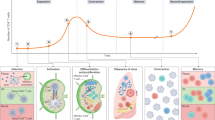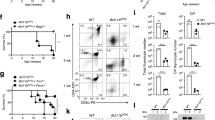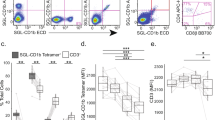Abstract
MOLECULES encoded by the human GDI locus on chromosome 1 (ref. 33) are recognized by selected CD4−8− T-cell clones expressing either αβ or γδ T-cell antigen receptors1,2. The known structural resemblance of GDI molecules to antigen-presenting molecules encoded by major histocompatibility complex (MHG) genes on human chromosome 6 (refs 3, 4, 34, 35), suggested that GDI may represent a family of antigen-presenting molecules separate from those encoded in the MHC1,5,6. Here we report that the proliferative and cytotoxic responses of human CD4−8− αβTCR+ T cells specific for Mycobacterium tuberculosis can be restricted by GDlb, one of the four identified protein products of the GDI locus. The responses of these T cells to M. tuberculosis seemed not to involve MHG encoded molecules, but were absolutely dependent on the expression of GDlb by the antigen-presenting cell and involved an antigen processing requirement similar to that seen in MHC class Il-restricted antigen presentation. These results provide, to our knowledge, the first direct evidence for the proposed antigen-presenting function of GDI molecules and suggest that the GDI family plays a role in cell-mediated immunity to microbial pathogens.
This is a preview of subscription content, access via your institution
Access options
Subscribe to this journal
Receive 51 print issues and online access
$199.00 per year
only $3.90 per issue
Buy this article
- Purchase on SpringerLink
- Instant access to full article PDF
Prices may be subject to local taxes which are calculated during checkout
Similar content being viewed by others
References
Porcelli, S. et al. Nature 341, 447–450 (1989).
Faure, F., Jitsukawa, S., Miossec, C. & Hercend, T. Eur. J. Immun. 20, 703–706 (1990).
Calabi, F. & Milstein, C. Nature 323, 540–543 (1986).
Balk, S. P., Bleicher, P. A. & Terhorst, C. Proc. natn. Acad. Sci. U.S.A. 86, 252–256 (1989).
Strominger, J. L. Cell 57, 895–898 (1989).
Porcelli, S., Band, H. & Brenner, M. B. Immun. Rev. 120, 137–183 (1991).
Boumsell, L. in Leukocyte Typing IV (eds Knapp, W. et al.) 251–254 (1989).
Zenmour, J., Little, A.-M., Schendel, D. J. & Parham, P. J. Immun. 148, 1941–1948 (1992).
Balk, S. P. et al. Science 253, 1411–1415 (1991).
Salter, R. D., Howell, D. N. & Cresswell, P. Immunogenetics 21, 235–246 (1985).
Erlich, H., Lee, J. S., Petersen, J. W., Bugawan, T. & DeMars, R. Hum. Immun. 16, 205–219 (1986).
Parham, P. Nature 357, 193–194 (1992).
Hosken, N. A. & Bevan, M. J. Science 248, 367–370 (1990).
Wei, M. & Cresswell, P. Nature 356, 443–446 (1992).
Ziegler, H. K. & Unanue, E. R. Proc. natn. Acad. Sci. U.S.A. 79, 175–179 (1982).
Chesnut, R. W., Colon, S. M. & Grey, H. M. J. Immun. 129, 2382–2388 (1982).
Riberdy, J. M. & Cresswell, P. J. Immun. 148, 2586–2590 (1992).
Janeway, C. A. Jr, Jones, B. & Hayday, A. C. Immun. Today 6, 73–76 (1988).
Bluestone, J. A. & Matis, L. A. J. Immun. 142, 1785–1788 (1989).
Olive, D., Dubreuil, P. & Mawas, C. Immunogenetics 20, 253–264 (1984).
Glimcher, L. H. & Shevach, E. M. J. exp. Med. 156, 640–645 (1982).
Panchamoorthy, G. et al. J. Immun. 147, 3360–3369 (1991).
Reinherz, E., Kung, P. C., Goldstein, G., Levey, R. H. & Schlossman, S. F. Proc. natn. Acad. Sci. U.S.A. 77, 1588–1592 (1980).
Martin, L. H., Calabi, F., Lefebvre, F.-A., Bilsland, C. A. G. & Milstein, C. Proc. natn. Acad. Sci. U.S.A. 84, 9189–9193 (1987).
Brodsky, F. M. & Parham, P. P. J. Immun. 128, 129–135 (1982).
Lanier, L. L., Ruitenberg, J. J., Allison, J. P. & Weiss, A. in Leukocyte Typing III (ed. McMichael, A. J.) 175–178 (Oxford Univ. Press, Oxford, 1987).
Shiue, L., Gorman, S. D. & Parnes, J. R. J. exp. Med. 168, 1993–2005 (1988).
Anegon, I., Grolleau, D. & Soulillou, J. P. J. Immun. 147, 3973–3980 (1991).
Morita, C. T. et al. Eur. J. Immun. 21, 2999–3007 (1991).
Favaloro, E. J. et al. Disease Markers 4, 261–270 (1986).
Shaw, S., Ziegler, A. & DeMars, R. Hum. Immun. 12, 191–211 (1985).
Roncarolo, M. G. et al. J. Immun. 147, 781–787 (1991).
Albertson, D. G., Fishpool, R., Sherrington, P., Nacheva, E. & Milstein, C. EMBO J. 7, 2801–2805 (1988).
Martin, L. H., Calabi, F. & Milstein, C. Proc. natn. Acad. Sci. U.S.A. 83, 9154–9158 (1986).
Calabi, F., Jarvis, J. M., Martin, L. & Milstein, C. Eur. J. Immun. 19, 285–292 (1989).
Author information
Authors and Affiliations
Rights and permissions
About this article
Cite this article
Porcelli, S., Morita, C. & Brenner, M. CDlb restricts the response of human CD4−8−T lymphocytes to a microbial antigen. Nature 360, 593–597 (1992). https://doi.org/10.1038/360593a0
Received:
Accepted:
Issue Date:
DOI: https://doi.org/10.1038/360593a0



